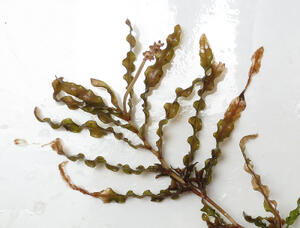Curly-Leaf Pondweed
Curly-leaf pondweed Potamogeton crispus
Where did curly-leaf pondweed come from?
- Curly-leaf pondweed is a native to Eurasia, Africa, and Australia.
- By 1950, curly-leaf pondweed had infested most of the U.S.
- Curly-leaf pondweed is found in Clark SFL, Pottawatomie #2 SFL, Kingman SFL, Ottawa SFL, Park City's Chisholm Pointe Pond, Lake Dabinawa, and Lake Wabaunsee.
What does curly-leaf pondweed look like?
- Curly-leaf pondweed is fast growing perennial.
- The stems are flattened and somewhat branching, 1 to 3 inches long and mostly 1/8 of an inch wide.
- The leaves are simple, long, narrow and attached directly to the stem.
- The flowers are brownish and inconspicuous and usually occur from May to October.
Why is curly-leaf pondweed a problem?
- In the spring, it forms dense mats which interfere with recreation and limit the growth of native aquatic plants. This plant does die back in mid-summer.
How do we control curly-leaf pondweed?
- Mechanical, biological, and chemical control techniques can be effective.
- Contact the Kansas Department of Agriculture for specific recommendations.
- Early detection of isolated populations may help prevent their spread. Your help to report new sightings and to prevent their spread is vital.
What do I do if I discover curly-leaf pondweed?
- If you discover curly-leaf pondweed, note the date and location, and contact your local Kansas Department of Agriculture office, the Emporia Research Office at (620) 342-0658, or email the Aquatic Nuisance Species Coordinator.
Images and Recent news
Curly-leaf Pondweed links:











